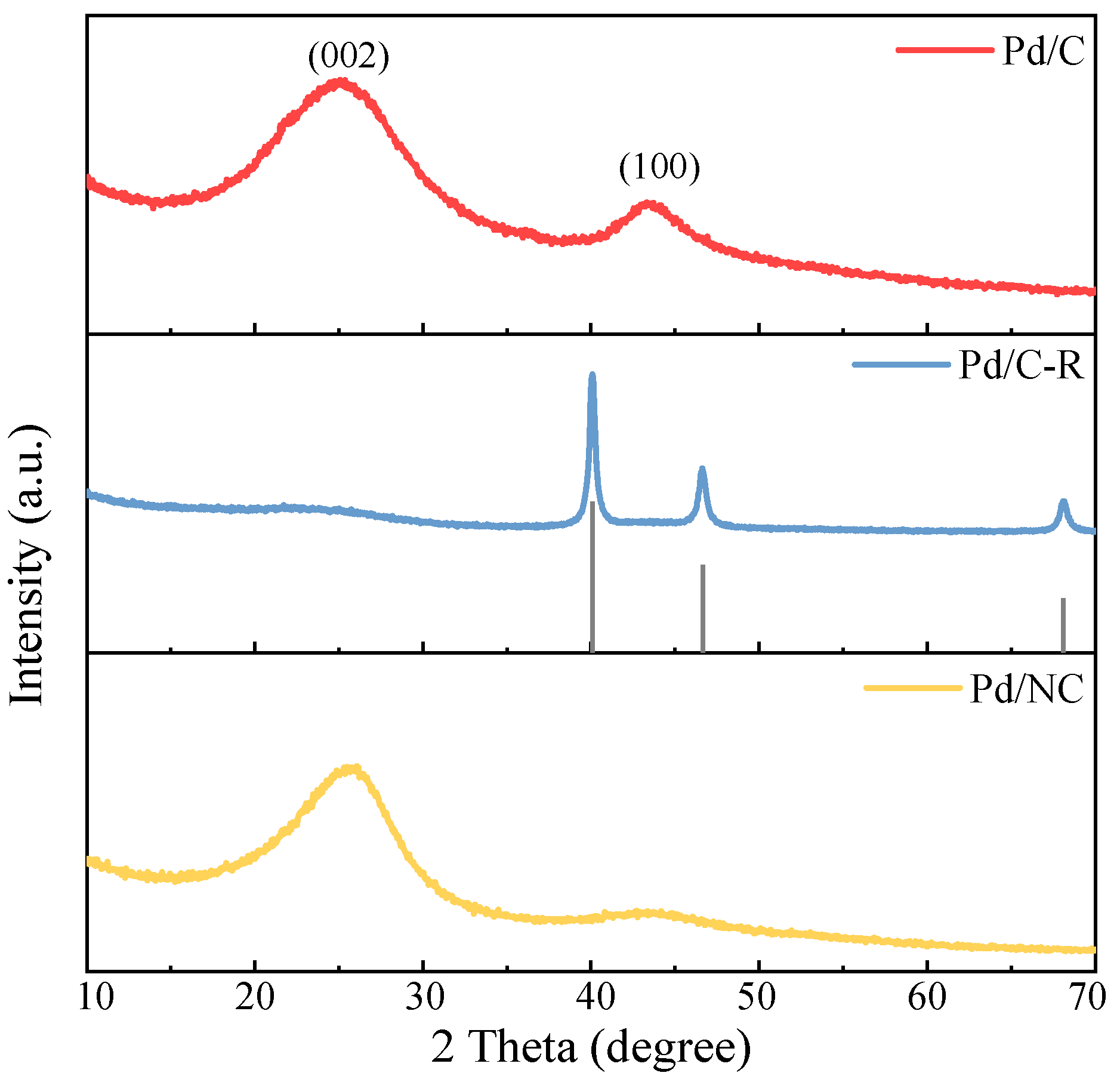Pd/C-Based Sensor for Gas Sensing in Transformer Oil
Abstract
:1. Introduction
2. Results and Discussions
2.1. Structural Characterization
2.2. Gas-Sensitive Tests
2.2.1. Response-Current Tests
2.2.2. Response-Recovery Tests
3. Materials and Methods
3.1. Experimental Materials
3.2. Materials Characterization and Tests
4. Conclusions
Supplementary Materials
Author Contributions
Funding
Institutional Review Board Statement
Informed Consent Statement
Data Availability Statement
Conflicts of Interest
References
- Wang, M.; Vandermaar, A.J.; Srivastava, K.D. Review of condition assessment of power transformers in service. IEEE Electr. Insul. Mag. 2002, 18, 12–25. [Google Scholar] [CrossRef]
- Bartley, W.H. Analysis of Transformer Failures. In Proceedings of the 36th Annual Conference on International Association of Engineering, Stockholm, Sweden, 15–17 September 2003. [Google Scholar]
- De Faria, H.; Costa, J.O.G.S.; Olivas, J.L.M. A review of monitoring methods for predictive maintenance of electric power transformers based on dissolved gas analysis. Renew. Sustain. Energy Rev. 2015, 46, 201–209. [Google Scholar] [CrossRef]
- Bakar, N.; Abu-Siada, A.; Islam, S. A review of dissolved gas analysis measurement and interpretation techniques. IEEE Electr. Insul. Mag. 2014, 30, 39–49. [Google Scholar] [CrossRef]
- Li, R.; Chen, Q.; Zhang, Y.; Ding, Y. Insight into Diffusion-Rebonding of Nano-Al2O3 on Fe Surface in High-temperature Thermal Energy Storage System. Appl. Surf. Sci. 2020, 530, 147249. [Google Scholar] [CrossRef]
- Chatterjee, A.; Bhattacharjee, P.; Roy, N.K.; Kumbhakar, P. Usage of nanotechnology based gas sensor for health assessment and maintenance of transformers by DGA method. Int. J. Electr. Power Energy Syst. 2013, 45, 137–141. [Google Scholar] [CrossRef]
- Soni, R.; Mehta, B. Review on Asset Management of Power Transformer by Diagnosing Incipient Faults and Faults Identification Using Various Testing Methodologies. Eng. Fail. Anal. 2021, 128, 105634. [Google Scholar] [CrossRef]
- Li, S.; Ge, Z.; Abu-Siada, A.; Yang, L.; Wakimoto, K. A new technique to estimate the degree of polymerization of insulation paper using multiple aging parameters of transformer oil. IEEE Access 2019, 7, 157471–157479. [Google Scholar] [CrossRef]
- Feng, D.; Wang, Z.; Jarman, P. Transmission power transformer assessment using furan measurement with the aid of thermal model. In Proceedings of the International Conference on Condition Monitoring & Diagnosis, Bali, Indonesia, 23–27 September 2013. [Google Scholar]
- Wang, B.; Jin, C.; Shao, S.; Yue, Y.; Zhang, Y.; Wang, S.; Chang, R.; Zhang, H.; Zhao, J.; Li, X. Electron-deficient Cu site catalyzed acetylene hydrochlorination-ScienceDirect. Green Energy Environ. 2023, 8, 1128–1140. [Google Scholar] [CrossRef]
- Wani, S.A.; Gupta, D.; Farooque, M.U.; Khan, S.A. Multiple incipient fault classification approach for enhancing the accuracy of dissolved gas analysis (DGA). Sci. Meas. Technol. IET 2019, 13, 959–967. [Google Scholar] [CrossRef]
- Polansk, R.; Hahn, P.; Kadlec, P.; Moravcová, D.; Prosr, P. Quantifying the Effect of Catalysts on the Lifetime of Transformer Oil. Appl. Sci. 2020, 10, 1309. [Google Scholar] [CrossRef] [Green Version]
- Zhang, Z.; Zhang, H.; Wang, B.; Yue, Y.; Zhao, J. Migration: A Neglected Potential Contribution of HCl-Oxidized Au (0). Molecules 2023, 28, 1600. [Google Scholar] [CrossRef] [PubMed]
- Faiz, J.; Soleimani, M. Dissolved Gas Analysis Evaluation in Electric Power Transformers using Conventional Methods a Review. IEEE Trans. Dielectr. Electr. Insul. A Publ. IEEE Dielectr. Electr. Insul. Soc. 2017, 24, 1239–1248. [Google Scholar] [CrossRef]
- Li, S.; Wu, G.; Gao, B.; Hao, C.; Xin, D.; Yin, X. Interpretation of DGA for transformer fault diagnosis with complementary SaE-ELM and arctangent transform. IEEE Trans. Dielectr. Electr. Insul. 2016, 23, 586–595. [Google Scholar] [CrossRef]
- Li, S.; Yang, L.; Li, S.; Zhu, Y.; Abu-Siada, A. Effect of AC-voltage harmonics on oil impregnated paper in transformer bushings. IEEE Trans. Dielectr. Electr. Insul. 2020, 27, 26–32. [Google Scholar] [CrossRef]
- Abu-Siada, A. A New Approach to Identify Power Transformer Criticality and Asset Management Decision Based on Dissolved Gas-in-Oil Analysis. IEEE Trans. Dielectr. Electr. Insul. 2012, 19, 1007–1012. [Google Scholar] [CrossRef]
- Wang, D.; Zhou, L.; Yang, Z.X.; Cui, Y.; Wang, L.; Jiang, J.; Guo, L. A New Testing Method for the Dielectric Response of Oil-Immersed Transformer. IEEE Trans. Ind. Electron. 2020, 67, 10833–10843. [Google Scholar] [CrossRef]
- Behjat, V.; Vahedi, A.; Setayeshmehr, A.; Borsi, H.; Gockenbach, E. Sweep frequency response analysis for diagnosis of low level short circuit faults on the windings of power transformers: An experimental study. Int. J. Electr. Power Energy Syst. 2012, 42, 78–90. [Google Scholar] [CrossRef]
- Zupeng, C.; Evgeniya, V.; Sharon, M.; Edvin, F.; Ortuño, M.A.; Núria, L.; Collins, S.M.; Midgley, P.A.; Sylvia, R.; Gianvito, V. A heterogeneous single-atom palladium catalyst surpassing homogeneous systems for Suzuki coupling. Nat. Nanotechnol. 2018, 13, 702–707. [Google Scholar]




Disclaimer/Publisher’s Note: The statements, opinions and data contained in all publications are solely those of the individual author(s) and contributor(s) and not of MDPI and/or the editor(s). MDPI and/or the editor(s) disclaim responsibility for any injury to people or property resulting from any ideas, methods, instructions or products referred to in the content. |
© 2023 by the authors. Licensee MDPI, Basel, Switzerland. This article is an open access article distributed under the terms and conditions of the Creative Commons Attribution (CC BY) license (https://creativecommons.org/licenses/by/4.0/).
Share and Cite
Lin, H.; Guo, J.; Yang, D.; Li, S.; Liu, D.; Liu, C.; Zhang, Z.; Wang, B.; Zhang, H. Pd/C-Based Sensor for Gas Sensing in Transformer Oil. Catalysts 2023, 13, 1113. https://doi.org/10.3390/catal13071113
Lin H, Guo J, Yang D, Li S, Liu D, Liu C, Zhang Z, Wang B, Zhang H. Pd/C-Based Sensor for Gas Sensing in Transformer Oil. Catalysts. 2023; 13(7):1113. https://doi.org/10.3390/catal13071113
Chicago/Turabian StyleLin, Haidan, Jiachang Guo, Daiyong Yang, Shouxue Li, Dan Liu, Changyan Liu, Zilong Zhang, Bolin Wang, and Haifeng Zhang. 2023. "Pd/C-Based Sensor for Gas Sensing in Transformer Oil" Catalysts 13, no. 7: 1113. https://doi.org/10.3390/catal13071113
APA StyleLin, H., Guo, J., Yang, D., Li, S., Liu, D., Liu, C., Zhang, Z., Wang, B., & Zhang, H. (2023). Pd/C-Based Sensor for Gas Sensing in Transformer Oil. Catalysts, 13(7), 1113. https://doi.org/10.3390/catal13071113






